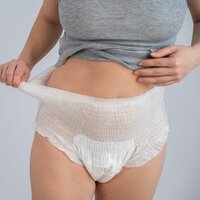There are no products in your shopping cart yet.
Bladder and urinary complaints during menopause.

During menopause (defined as a year without menstruation, while the period before is referred to as the transition), women can experience bladder and urinary issues, ranging from stress incontinence to nighttime urination and painful urination. The root cause of these symptoms lies in the decreased levels of estrogen and progesterone. The interaction of these hormones affects the pelvic floor muscles and contributes to various bladder and urinary problems. This blog discusses the different types of issues and the solutions available.
Types of Bladder and Urinary Problems During Menopaus
Stress Incontinence
Stress incontinence is a form of urinary incontinence where involuntary urine leakage occurs during physical activities or movements that put pressure on the abdomen and pelvis. During menopause, characterized by a significant decrease in estrogen and progesterone levels, women may become more susceptible to stress incontinence. In menopausal stress incontinence, urine loss can occur during activities such as sneezing, coughing, laughing, lifting, exercising, or other movements that exert pressure on the abdomen. The weakened pelvic floor muscles and reduced support from surrounding tissues make it harder to maintain the urethral sphincter, leading to involuntary urine leakage.
Urge Incontinence
"Urge incontinence" in menopause refers to a form of urinary incontinence where women experience a sudden and intense urge to urinate and struggle to reach the toilet in time. This phenomenon is also known as urge incontinence or overactive bladder. Hormonal fluctuations can impact the health of the bladder and surrounding muscles, affecting control over urination. The exact causes of urge incontinence during the transition can vary, but hormonal changes play a significant role. Other factors, such as aging, weakened pelvic floor muscles, and underlying medical conditions, can also contribute to this problem.
Nighttime Urination (Nocturia)
Nighttime urination, also known as nocturia, can be a common symptom during the transition. This phenomenon involves waking up repeatedly during the night to urinate, which can negatively affect sleep quality and overall well-being. Factors contributing to nighttime urination include hormonal changes, reduced muscle elasticity, and increased bladder sensitivity.
Painful Urination (Dysuria)
Painful urination, also called dysuria, during the transition can be a symptom experienced by women due to hormonal changes and other factors characteristic of this stage of life.
Causes of Bladder and Urinary Problems During Menopause
The primary cause of bladder and urinary issues during menopause is the decline in progesterone and estrogen levels. This decline leads to changes in the structure and elasticity of the pelvic floor muscles and surrounding tissues, which can affect bladder support. Estrogen helps maintain the health of the urogenital system, including the muscles and tissues around the bladder and urethra. The reduced level of estrogen during menopause can weaken these structures, increasing the susceptibility to bladder and urinary problems. Mucous membranes become thinner and more sensitive, the risk of urinary tract infections increases due to hormonal changes, bladder control diminishes, and the bladder becomes more sensitive, increasing the urge to urinate.
What Can You Do About Bladder and Urinary Issues?
- Pelvic Floor Exercises: These can help strengthen the muscles around the bladder and urethra. Train pelvic floor muscles three times a day by contracting them, holding for a few seconds, and then releasing.
- Bladder Training: Structuring toilet visits at fixed times to train the bladder to hold urine longer.
- Avoiding Triggers: Avoid caffeine, alcohol, and other potential irritants that can increase the urge to urinate.
- Balance Plus Cream: Consider using Balance Plus Cream to restore hormonal balance.
- Preventing Overweight: Every extra kilogram adds more pressure on the bladder.
Conclusion: Bladder and Urinary Issues During Menopause
Due to the decrease in estrogen and progesterone, muscles and tissues can weaken. Start using hormone creams in time. If you're in the transition, begin with progesterone cream. If you're nearing the end of the transition or already in menopause, switch to Balance Plus Cream. Prevention is preferable.


